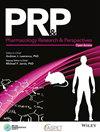Piezo 1 机械感受器参与了雌雄达尔盐敏感高血压大鼠离体小阻力动脉血管僵化的研究
IF 2.9
4区 医学
Q2 PHARMACOLOGY & PHARMACY
引用次数: 0
摘要
压电是一种对机械敏感的非选择性阳离子通道,被认为参与了血管的发育和功能。我们的研究旨在确定机械敏感性 Piezo 1 通道对血管壁僵硬度的贡献是否具有性别特异性。我们使用压力肌电图实验法测定了达氏盐敏感雌雄正常血压大鼠和高血压大鼠(n = 6-8)的三阶肠系膜动脉(完整和剥离)的复合杨氏模量(CYM)。在完整和剥离的血管中研究了 Piezo 1 激动剂(Yoda 1; 10 μM)和拮抗剂(GsMTx-4; 2 μM)的作用。使用免疫组织化学方法确定了 Piezo 1 的分布。在完整的血管中,各实验组之间的 CYM 没有差异,然而,与高血压男性相比,去除内皮后,正常血压男性和女性组的 CYM 明显增加。尤达 1 的存在对各组的 CYM 均无影响。在完整组织中,GsMTx-4 会导致高血压女性、正常血压男性和女性的 CYM 显著增加,但不会影响高血压男性。在剥脱的血管中,GsMTx-4 能使 CYM 显著增加,但仅适用于正常血压的女性。在男性和女性血管中发现了不同的 Piezo 1 表达。我们的研究结果表明,与血压正常的男性或女性相比,Piezo 1 机械感受器对男性高血压患者血管生物力学的贡献更大。证据还表明,Piezo 1 在血管内皮细胞和血管平滑细胞中可能起着不同的血管调节作用,男性的贡献大于女性。本文章由计算机程序翻译,如有差异,请以英文原文为准。
Involvement of Piezo 1 mechanoceptors in vascular stiffness in isolated small resistance arteries of male and female Dahl salt‐sensitive hypertensive rats
Piezo are mechanosensitive non‐selective cation channels that are suggested to be involved in vascular development and function. The aim of our study was to determine any sex‐specific contributions of the mechanosensitive Piezo 1 channels on blood vessel wall stiffness. Composite Young modulus (CYM) was determined using pressure myograph experimental approach using third‐order mesenteric arteries (intact and denuded) from Dahl salt‐sensitive male and female normotensive and hypertensive rats (n = 6–8). The effects of Piezo 1 agonist (Yoda 1; 10 μM), and antagonist (GsMTx‐4; 2 μM) were studied in intact and denuded vessels. The distribution of Piezo 1 was identified using immunohistochemistry. In intact blood vessels, there were no differences in CYM between the experimental groups, however, removal of the endothelium unmasked significant increases in CYM in normotensive males and female groups compared to hypertensive males. The presence of Yoda 1 did not affect CYM in any groups. In the intact tissues, GsMTx‐4 led to significant increases in CYM in hypertensive females, and normotensive males and females, but not in hypertensive males. In the denuded vessels, GsMTx‐4, produced a significant increase in CYM but only in the female normotensives. Differential expression of Piezo 1 were found in male versus female blood vessels. Our findings support a greater contribution of Piezo 1 mechanoceptors to vascular biomechanics of male hypertensive compared to male normotensive or female groups. The evidence also points to a possible differential vasoregulatory role for Piezo 1 in endothelial versus vascular smooth cells, with a greater contribution in males than females.
求助全文
通过发布文献求助,成功后即可免费获取论文全文。
去求助
来源期刊

Pharmacology Research & Perspectives
Pharmacology, Toxicology and Pharmaceutics-General Pharmacology, Toxicology and Pharmaceutics
CiteScore
5.30
自引率
3.80%
发文量
120
审稿时长
20 weeks
期刊介绍:
PR&P is jointly published by the American Society for Pharmacology and Experimental Therapeutics (ASPET), the British Pharmacological Society (BPS), and Wiley. PR&P is a bi-monthly open access journal that publishes a range of article types, including: target validation (preclinical papers that show a hypothesis is incorrect or papers on drugs that have failed in early clinical development); drug discovery reviews (strategy, hypotheses, and data resulting in a successful therapeutic drug); frontiers in translational medicine (drug and target validation for an unmet therapeutic need); pharmacological hypotheses (reviews that are oriented to inform a novel hypothesis); and replication studies (work that refutes key findings [failed replication] and work that validates key findings). PR&P publishes papers submitted directly to the journal and those referred from the journals of ASPET and the BPS
 求助内容:
求助内容: 应助结果提醒方式:
应助结果提醒方式:


